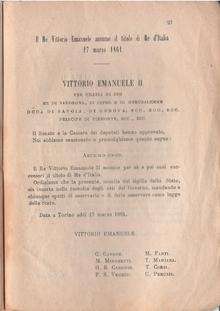Proclamation of the Kingdom of Italy
The proclamation of the Kingdom of Italy was the formal act that sanctioned the birth of the unified Kingdom of Italy. It happened with a normative act of the Kingdom of Sardinia - the law 17 March 1861, n. 4761 - with which Victor Emmanuel II of Savoy assumed for himself and for his successors the title of King of Italy.[1] March 17 is commemorated annually by the Anniversary of the Unification of Italy, a national holiday established in 1911 on the occasion of the 50th anniversary, and also celebrated, in the Republican era, in 1961 and 2011.
| Proclamation of the Kingdom of Italy | |
|---|---|
 | |
| Parliament of the Kingdom of Sardinia | |
Long title
| |
| Citation | Law No. 4761 of 1861 |
| Territorial extent | Whole of Italy |
| Enacted by | Parliament of the Kingdom of Sardinia |
| Enacted | 17 March 1861 |
| Introduced by | Prime Minister of Italy Camillo Benso, Count of Cavour |
| Status: In force | |
History

Following the Second Italian War of Independence and the Expedition of the Thousand, led by Giuseppe Garibaldi, in the two-year period 1859-60, the goal of the unification of Italy had been largely achieved, with the sole exception of the Triveneto and Lazio. The annexation to the Kingdom of Sardinia of the various provinces had been sanctioned by a series of plebiscites. However, the new state still carried the name of Kingdom of Sardinia.
On February 18, 1861, the new Parliament, already known as the Italian Parliament, met in Turin, at Palazzo Carignano, formerly the seat of the Parliament of the Kingdom of Sardinia, even though it was numbered as VIII, thus continuing the numbering of the legislatures of the Kingdom of Sardinia. The Chamber of Deputies of the Kingdom of Italy also included parliamentarians elected in the "new provinces", while the Senate of the Kingdom of Italy, not elected but appointed by the king, had been integrated with appointments of senators from different parts of Italy.
The opening of the new legislature took place with the speech of the Crown pronounced by the King. The Senate in the reply voted on February 26 spoke explicitly of a new realm. The Chamber of Deputies in the response speech to Victor Emmanuel II of Savoy, written by Giuseppe Ferrari and dated 13 March 1861, already declared that:
The suffrages of a whole people place the crown of Italy on your head blessed by Providence

Immediately after the start of the legislature, on 21 February, the then Prime Minister Camillo Benso, Count of Cavour presented to the Senate a bill, consisting of a single article, to formalize the new name of the King.[2] This became law on March 17, 1861, with the publication in the Official Journal of the Kingdom of Italy n.67.[3] March 17 is commemorated annually by the Anniversary of the Unification of Italy, a national holiday established in 1911 on the occasion of the 50th anniversary.
The law
The royal decree read:
PROJECT OF LAW. Single item. King Victor Emmanuel II takes the title of King of Italy for himself and his successors
In the Report Cavour recalled that
Parliament, on the solemn day of the royal session, with the enthusiasm of gratitude and affection, hailed Victor Emmanuel II, King of Italy.
However, in the text approved by the Senate a second article also appears on the question of the heading of legislative acts. It was therefore established that:
Art. 2. The acts of the Government and any other act which must be titled in the name of the King will be headed with the following formula: (In the name of the King) By Divine Providence, by vote of the Nation KING OF ITALY
The numeral of Victor Emmanuel of Savoy continued to be "second", not "first", as a sign of the continuity of the House of Savoy dynasty which had achieved Italian unification[4] and of the continuity of the Statuto Albertino.
Citations
- Regno di Sardegna, Regno d'Italia, Repubblica Italiana
- Carlo Belviglieri Storia d'Italia dal 1814 al 1866 vol 5 e 6 p.289
- "Gazzetta n. 67 del 17 marzo 1861". Archived from the original on 2016-10-31. Retrieved 2019-10-01.
- Alfredo Oriani, La lotta politica in Italia 1892 in Tommaso Detti, Giovanni Gozzini, Ottocento, Pearson Paravia Bruno Mondadadori, 2000, p.184
External links
- "Proclamazione Regno d'Italia" (in Italian).
- "Nascita Regno d'Italia" (in Italian).
- "La proclamazione del Regno d'Italia e la Valle d'Aosta" (PDF) (in Italian).
- "Regno di Sardegna, Regno d'Italia, Repubblica Italiana" (in Italian).
.jpg)